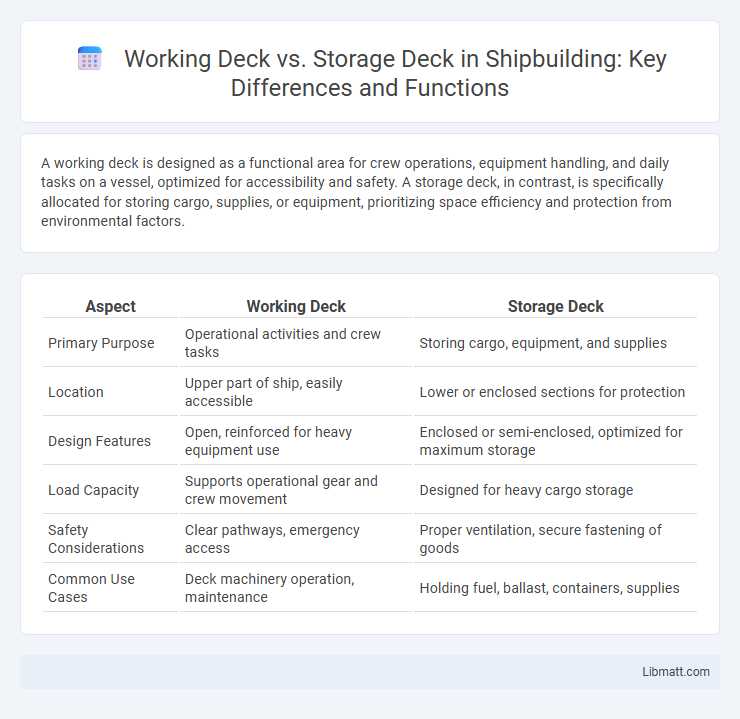A working deck is designed as a functional area for crew operations, equipment handling, and daily tasks on a vessel, optimized for accessibility and safety. A storage deck, in contrast, is specifically allocated for storing cargo, supplies, or equipment, prioritizing space efficiency and protection from environmental factors.
Table of Comparison
| Aspect | Working Deck | Storage Deck |
|---|---|---|
| Primary Purpose | Operational activities and crew tasks | Storing cargo, equipment, and supplies |
| Location | Upper part of ship, easily accessible | Lower or enclosed sections for protection |
| Design Features | Open, reinforced for heavy equipment use | Enclosed or semi-enclosed, optimized for maximum storage |
| Load Capacity | Supports operational gear and crew movement | Designed for heavy cargo storage |
| Safety Considerations | Clear pathways, emergency access | Proper ventilation, secure fastening of goods |
| Common Use Cases | Deck machinery operation, maintenance | Holding fuel, ballast, containers, supplies |
Introduction to Deck Types
Working decks are designed primarily for operational activities, featuring durable surfaces and strategic layouts to support heavy equipment handling, crew movement, and safety protocols on ships or offshore platforms. Storage decks are optimized for the secure stowage of cargo, materials, or equipment, emphasizing space efficiency, load distribution, and protection from environmental factors. Both deck types serve crucial roles in maritime and offshore industries, balancing functionality and safety to ensure seamless operations.
Defining Working Decks
Working decks are specifically designed areas on vessels or platforms where operational tasks are conducted, featuring reinforced surfaces and equipment to support heavy-duty activities. These decks prioritize functionality, safety, and accessibility to facilitate crew workflows, unlike storage decks, which mainly serve as spaces for holding materials or goods. Understanding the unique structural and operational characteristics of working decks helps optimize your maritime or industrial project efficiency.
Defining Storage Decks
Storage decks are designated areas on ships or offshore platforms specifically designed for securely holding equipment, materials, and cargo to prevent damage and ensure operational efficiency. These decks typically feature reinforced structures, weatherproofing, and organized layouts to facilitate safe storage and easy access. Unlike working decks, which prioritize operational activities and crew movement, storage decks focus on maximizing space utilization for inventory management and safeguarding assets.
Key Features of Working Decks
Working decks are designed for functionality, featuring durable, non-slip surfaces, easy access to equipment, and reinforced structures to support heavy loads. These decks often include built-in tool holders, storage compartments, and customizable layouts to enhance workflow efficiency. Your choice of a working deck ensures safety and productivity in demanding environments compared to storage decks, which primarily focus on maximizing space for item organization.
Key Features of Storage Decks
Storage decks are designed with reinforced flooring to support heavy loads and maximize space efficiency, making them ideal for bulk storage. They often include modular shelving systems and easy access points to facilitate organized inventory management. Enhanced durability and corrosion-resistant materials ensure long-term performance in industrial environments.
Functional Differences: Working vs Storage Decks
Working decks are designed for active use, featuring durable, non-slip surfaces and ample space for tasks such as equipment handling and maintenance, ensuring safety and efficiency. Storage decks prioritize maximizing cargo capacity and organization, often with reinforced flooring and securing systems tailored to hold various types of goods securely in transit. The primary functional difference lies in the working deck's focus on operational activities versus the storage deck's emphasis on inventory management and cargo protection.
Material Choices for Each Deck
Working decks are typically constructed from durable materials like pressure-treated lumber, composite decking, or hardwoods such as ipe or teak to withstand heavy foot traffic and weather exposure. Storage decks prioritize cost-effective and sturdy materials such as treated pine or plywood, often with less emphasis on aesthetic finishes since they are primarily functional spaces. Your choice between working and storage decks should consider the material's durability, maintenance needs, and intended use to ensure long-lasting performance.
Safety Considerations
Working decks are designed for frequent human activity, necessitating enhanced safety features like non-slip surfaces, guardrails, and clear walkways to prevent accidents, while storage decks prioritize maximizing load capacity and structural integrity to support heavier weights without compromising stability. Proper load distribution and secure fastening on storage decks reduce the risk of shifting cargo that could endanger personnel on adjacent working decks. Your safety depends on adhering to these design distinctions and regularly inspecting decks to maintain their protective functions.
Maintenance Requirements
Working decks demand frequent maintenance due to constant exposure to heavy foot traffic, equipment, and environmental elements, requiring regular inspections, cleaning, and repairs to prevent wear and safety hazards. Storage decks, designed primarily for load-bearing rather than active use, typically experience less surface wear but require vigilant monitoring for structural integrity and moisture control to avoid deterioration over time. Implementing proper sealing, prompt damage repair, and routine assessment is crucial for extending the lifespan and performance of both working and storage decks.
Choosing the Right Deck for Your Needs
A working deck offers a durable, slip-resistant surface ideal for active use and heavy foot traffic, making it perfect for outdoor tasks and social gatherings. In contrast, a storage deck is designed to maximize space, incorporating built-in compartments and easy access for organized storage solutions. Selecting the right deck depends on prioritizing functionality: choose a working deck for versatility and safety or a storage deck to enhance organization and declutter outdoor areas.
Working deck vs storage deck Infographic

 libmatt.com
libmatt.com